
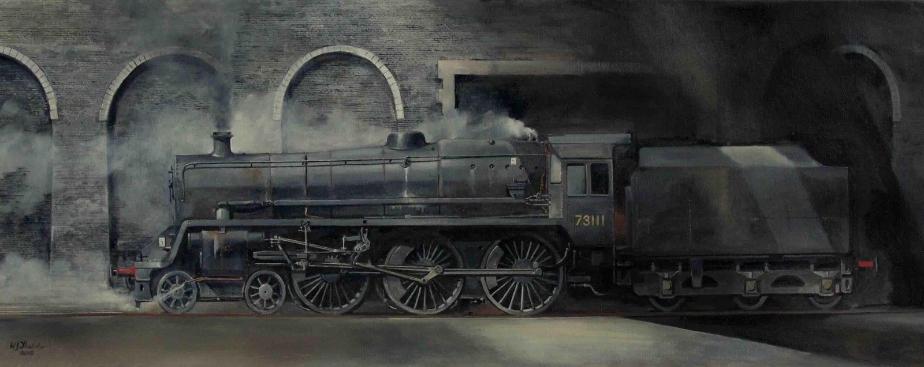
PHOTOGRAPHER UNKNOWN
FROM STEAM TO DIESEL
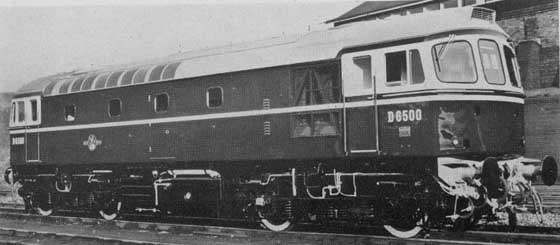
PHOTOGRAPHER UNKNOWN
Southern Region BRCW TYPE 3 Locomotive (Class 33)
In August 1968 saw the withdrawal of steam locomotives on the Southern Region
a new classification for diesel & electric locomotives was introduced with the B.R.C.W.
TPYE 3’s (latter Class 33’s) at the beginning of the 1960s.
With the Nationalisation of the railways in 1948, the need to modernise the railways was to
become very apparent. With introduction of the “Modernisation Plans” of 1956, this was to
see the beginning of the phasing out of steam locomotives, and replacing them with new
forms of motive power traction, electric and diesel, locomotives and multiple units.
The main diesel locomotive to be introduce on the Southern Region, was to a TYPE 3
locomotive (latter Class 33s), even though it was not originally part of the “Modernisation
Plan”.
The original plan was to order more English Electric Co - Co TYPE 3s locomotive (latter
class 37s) already in production for the Southern Region, but the Co - Co wheel arrangement was deemed to heavy for the permanent way.
Over the next ten years (1957 - 1967) steam locomotive on the Southern Region was to slowly to be replaced by them on the Central Division with the last Central Division loco shed closing on the 12th June 1965.
Between 1957 and 1960, four orders were placed for the new TYPE 3 diesel locomotives, with a total of 98 locomotives being built for the Southern Region. This is also included 12
narrowed bodied locomotive for the Hastings to Tonbridge line.
On July 17th, 1960, the following locomotives D6506On July 17th, 1960, the following
locomotives D6506, E5004 & 20001 were on trial Three Bridges and Haywards Heath
station, with several test runs at various speeds were being made between these locations,
and later in March 1961, Type 3 locomotives were being used to test the bridges between
Lewes - Barcombe Mills, this was done in conjunction with a West Country Pacific.
In August 1962, saw the TYPE locomotives, continuing to expand across the Central
Division, which included various freight workings, empty coaching stock workings between
New Cross Gate and London Bridge, assorted engineering workings, and an early morning
diagram between London Bridge and Brighton. They were also visitors to Brighton and
Eastbourne on summer passengers workings.
By the end of July, 1963, the Central Division had nineteen TYPE 3 locomotives available
and a large number of Diesel Electric Multiple Units, this had a great impact on the remains
steam duties within the the Central Division. This diesel regularly working over the Oxted
lines, and TYPE 3 locomotives taking over the Saturday workings of the 09.40 Brighton -
Bournemouth and the 13.45 return.The weekday working continued to be in the hands of the West Country Pacifics. By the end of the summer timetable saw Brighton losing the duties for its Pacific’s class locomotives, and they were transferred away to other sheds.
With the implementation of the Beeching Report routes in Sussex were closed reducing the
amount of steam workings at Brighton, Bognor, Horsham, Three Bridges, Eastbourne and
Tunbridge Wells West Depots. Bognor steam shed closed in November1961 its work
transferred to Brighton. Newhaven and Tunbridge Wells West steam sheds closed on September 9th 1963, however the remaining work at Tunbridge Wells West Depot was
replaced by diesels electric multiple units (D.E.M.U.s).
Bognor steam shed closed on the 8th November, 1961, Enginemen transferred to Brighton
steam shed.
Horsham steam shed closed on the 12th June 1964. Enginemen transferred to Three Bridges Mixed Traction depot.
Three Bridges steam shed closed on the 27th January 1964 and become a Mixed Traction
depot which closed in November 1968.
Brighton Steam shed closed on the 12 June 1964 and become a Mixed Traction depot.
Eastbourne steam shed closed on the 13th June 1965 and become a Mixed Traction depot
which closed in November 1968
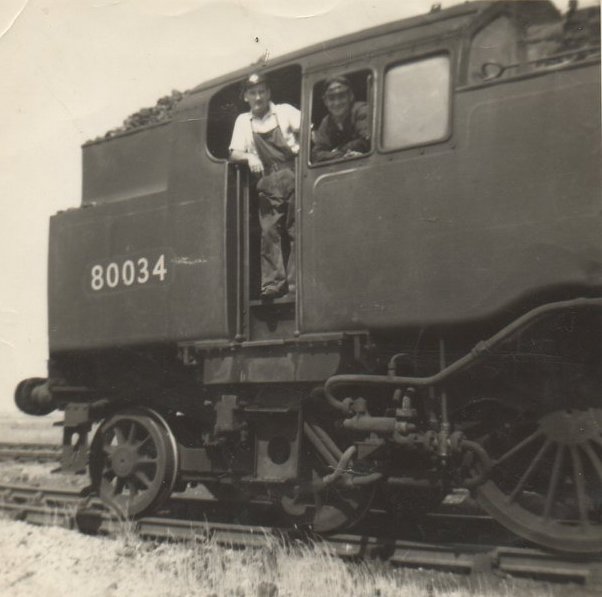
This resulted in many Drivers and Firemen being made redundant at their Depots and
subsequently having to move to other Depots to stay in employment. From the late 1950s
onwards it was not uncommon especially in rural areas of the Country for Drivers and
Firemen with between 30 and 40 years service having to leave British Railway rather than
move their Family’s hundreds of miles to keep their jobs.
Whilst many factors contributed to these events, no doubt the presence of diesel locomotives
and multiple units available for traffic were a contributing factor. This was seen in January
1964, when a revision of the services on the Oxted line, led to a major overall reduction in
passenger train mileage, and the elimination of the remaining Uckfield line steam workings,
and the continued use of the diesel locomotive and multiple units on some of these services.
On January 12th, 1964, the Sunday only Brighton - Bournemouth became diesel hauled,
using coaching stock from the Oxted line. For the summer season of 1964 a relief Brighton -
Cardiff operated using a Type 3 between Brighton & Salisbury. This class of locomotives
were also utilised on the Brighton - Plymouth. The weekday service used an electric
locomotive as far as Chichester; and on occasion a Type 3 would substitute. Following the
end of the summer timetable, the Brighton - Plymouth service would be the only long distance service from Brighton of those that once ran to places such as Bournemouth and Cardiff. The Plymouth service was hauled by Type 3's during the summer.
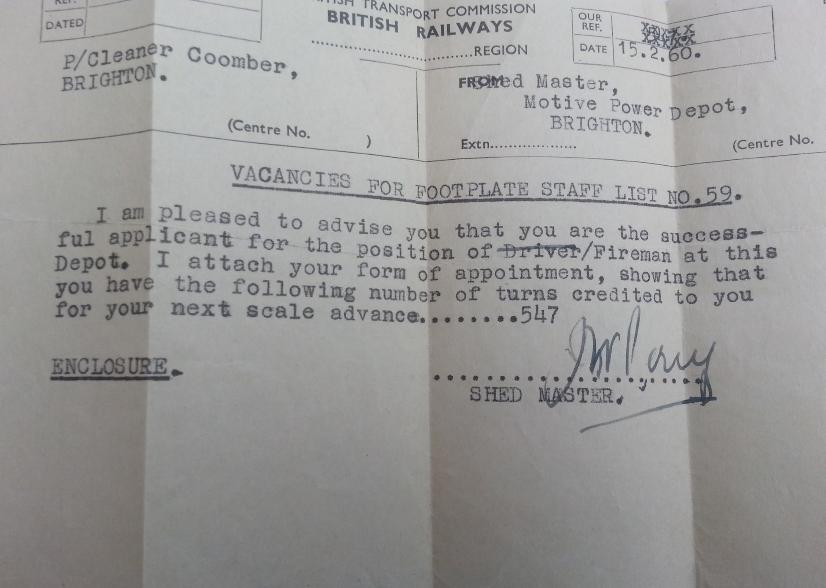
DAVID COOMBER COLLECTION
The changeover from Steam to Diesel Traction and subsequent drop in the requirement of Drivers and Firemen on the whole of British Railway became the issue of a Industrial Court of Inquiry in September 1965. On 26th December, 1964, the total number of Drivers,
Firemen and Cleaners on British Railways was 53,359. but by the 19th June, 1965, the total was 50,472; a reduction of 2,887 or 5.4 per cent in six months, and since July 1963 the number of Drivers has been reduced from 34,163 to 30,601; a reduction of 3,562; in the same period the establishment of Firemen and Cleaners has decreased from 28,744 to 19,299, a reduction of 9,445.
The reason for this Inquiry was British Railways intention to implement Single
Manning and to do away with the Second Man on Diesel Locomotives (This was introduced to replace the grade of Fireman) British Railways intention was also to alter P.N.B and driving arrangements for Drivers. This would have had another massive reduction in the number of Drivers and Secondmen required.A.S.L.E&.F gave evidence to the Court if Inquiry and this centred round the argument that “two sets of eyes are better than one” on whatever type of Locomotive and that the grade of Secondman was essential to help the Driver and to give valuable experience towards becoming a Driver themselves. Also the proposed Manning Arrangements would put undue strain on the remaining Drivers.
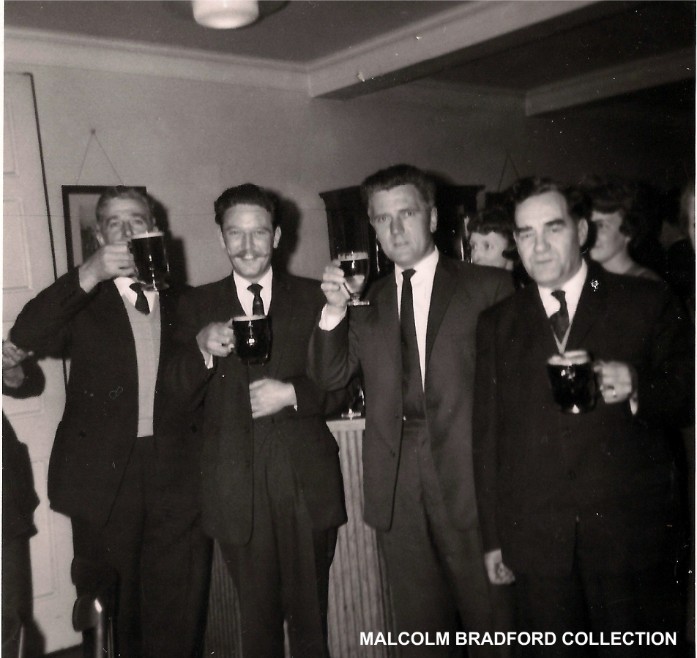
Left ~ Right: Brighton Enginemen
Les Bradford (), John Norton, Peter Bradford (08.11.1948) & Unknown
Peter was Brighton No.1 Branch Secretary between 1960 -1966.
The outcome of the Inquiry was that a number of the changes British Railways required were accepted but Single Manning of Locomotives was rejected also British Railways gave a full assurance not only that no footplate staff surplus to requirements as a result of the revised Agreement would be made redundant but that none would be moved from his present depot against his wishes. If footplate staff wished to move to another depot (e.g. to improveprospects of promotion to driver), they would benefit from the provisions of current
redundancy arrangements. In addition, to encourage retirement of drivers so as to provide
openings for firemen, drivers over 60 years of age at depots where firemen were surplus to
requirements in consequence of single-manning would be allowed to retire under the
redundancy procedure. Over·11,000 drivers were due to retire in the normal way over the
next five years and this would make it comparatively easy to absorb surplus footplatemen.
A.S.L.E. & F. were satisfied with these arrangements, although they pointed out that closure
of depots would cause some added hardship to footplatemen as they would either have to
move their homes or travel long distances.
“The Board also gave assurances that earnings of footplate staff affected by the revised
Agreement would be safeguarded".
This gave rise to the position of “STARRED MEN” where secondmen could remain at their
own depot until promoted to the position of driver without loss of earnings. This situation
remained in place at certian Mixed Traction depots for the next 20 years. At Brighton Mixed
Traction depot the last “STARRED MAN” on the Central Division was Relief Driver Ralph
Stobbart. Ralph his promotion to driver at Brighton Mixed Traction depot in 1987.
Steam working on the Central Division would continue to dwindle with the final workings and steam sheds closing in 1964 Eastbourne being the final steam shed to close .Although the final workings rostered for Steam Traction lasted until March 1967.These were the through Brighton –Plymouth service(because the coaching stock used required steam heating which the 33s could not provide) and the Waterloo-Bognor Regis Newspaper train (detached at Havant) although the Engines and Crew for these workings came from Fratton Shed on the South Western Division.
During the summer of 1967, the Central and South Eastern Division Diesel locomotive
diagrams were merged. This allowed the St Leonard's allocated Hastings gauge Type 3's to
wander further on a regular basis than previously, now handling passenger workings from
London to Brighton, East Grinstead, Crowborough, and on the Brighton Exeter through
working.
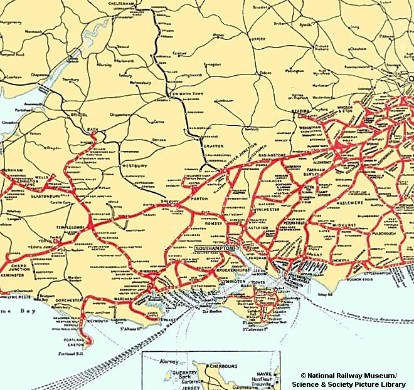
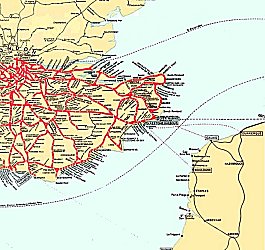
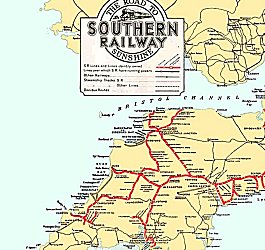
These maps enables you to see the full
extent of the area that the Southern Railway
operated over prior to nationalisation of the
railways in 1948. Under the Southern
Region control, some these lines were
transferred to the Great Western Region
control.
The maps also shows, how far many of the
engine-men moved from, during the
“Beeching Modernisation Plan” being
implemented, during the early 1960s. Many
of these men ended up in the Brighton and
surrounding area.
The two separate Brighton Branches worked side by side with all the Drivers and Secondmen working from the same location after 1964 upon the closure the Brighton Steam Shed. The separate grades of Enginemen and Motormen having being abolished in 1961.
Promotion within the loco department has always been on strict seniority with the date of entry as a cleaner being the deciding factor. At Brighton promotion was very slow as it was very rare for men to leave the Footplate except for medical reasons. It was not uncommon for the senior Firemen to be in their late 40s and still not having reached the position of Engineman. As stated earlier this was made worse for Brighton Firemen & Cleaners during the late 1950’s onwards when Enginemen and Firemen from the South Western Section (former L.S.W.R.) of the Southern Region were being forced to move around the Region looking for vacancies at depots within the Southern Region due to the even slower rate of promotion in that part of the country and also the start of the Railway cuts. Many footplate -men having to find themselves relocating their homes and families across the Southern Region (from as far away as Exmouth Junction. Barnstaple, Exeter, Yeovil, Templecombe, Dorchester, Bournemouth, Salisbury and Eastleigh). Many of these Footplate men moved to Brighton Locomotive depot where they remained for the rest of their careers. This held back many of the local Brighton Firemen and Engine Cleaners in gaining their promotion because the Footplate men transferring in had higher seniority dates. This forced some to seek their promotion to Enginemen and Motormen within the London area. Those Footplate men that transferred to the London area had many years of waiting before their seniority allowed them to transfer back to Brighton. Many of these former Brighton Footplate Men decided to stay at their new locations.
Brighton Driver George Washington and Fireman Reg Eason
George Washington’s seniority date 12.12.1911 and retired 22.04.1960
BRIGHTON ON LOAN
During this time, Brighton loco depot, become known as a ‘on loan’ depot with many of the
junior loco men going 'on loan’ to loco depots throughout the Central Division, Fratton,
Tunbridge Wells and Redhill, as well as the London depots such as Norwood, Stewarts Lane
and on some very occasions at Nine Elms.
The junior cleaners who were passed for firing, or the junior firemen who were passed for
driving, where often booked out ‘on loan’ to foreign depots during this time (and for many
years that followed) to carry out higher grade footplate work. This was the only way they
could achieve the 294 turns (this figure used to be 313) in the grade to enable them to go to
the next band of pay for their grade (there was a number of different rates for fireman and
drivers rates of pay). Those who went ‘on loan’ would still book on and off at Brighton Loco depot and would then travel to and from the foreign depot, where they would spend the day or night carrying out the higher grade duty. This quite often meant working on the shed, preparing and disposing of steam locomotives or working in the various yards on the
shunting locomotives, shunting the wagons and re-marshalling them into formation for their
later departure.
The junior passed cleaners and firemen would not often be promoted at their home depot,
owing to the work not being available for them. This was due to a large number of redundant and senior loco-men transferring into the depot and the phasing out of steam locomotives as a result of the introduction of diesel locomotives that replaced them.

On Friday 8th April, railway wagons become unhooked from the goods train on the down
line. It came off the track and crashed into the side of the subway. The station master was
alerted of the accident by the staff at the Health Clinic held above yer library then in the grey stone building opposite the subway and footbridge in Yattendon Road. A mother and her baby in a pram were in the subway when one of the wagons burst through and came to rest inverted, covering them in coke. Luckily the baby was uninjured but Mrs Willett received head injuries that required 17 stitches.
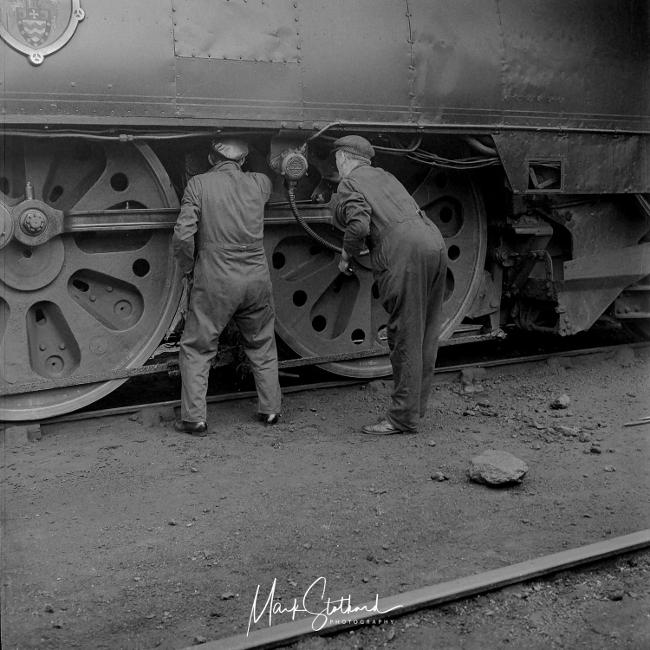
LOCOMOTIVE JOURNAL
APRIL 1960
PAGE 125
NEWHAVEN BRANCH
Some long time has elapsed since the last report from Newhaven. We will shortly be experiencing the Modernisation of Newhaven Harbour, which many throughout the country know as the embarkation port for their holiday to the Continent.
Our Loco., situated directly alongside the Quay, lends itself to many advantages connected with the modernisation which the management have indicated will receive their consideration at Joint Consultation level, in conjunction with the Shipping and Continential Manager. Private enterprise would no doubt welcome the co-operation we are prepared to offer, let us hope the B.T.C. will too.
A new tug has just bee launched named “Meeching”, which was the old name for Newhaven. 1960 starts off with as good a Branch Committee any new Secretary could wish for, namely, Bros. E. King, C. Wickenden, R. Morris, R. Turner, J. Nash, W. Ware, F. Goff, L. Lower and V. Harris, the latter being not only L.D.C. Chairman but a well-known local football referee.
I can now report 100% A.S.L.E.&F. membership.
S. Cheal,
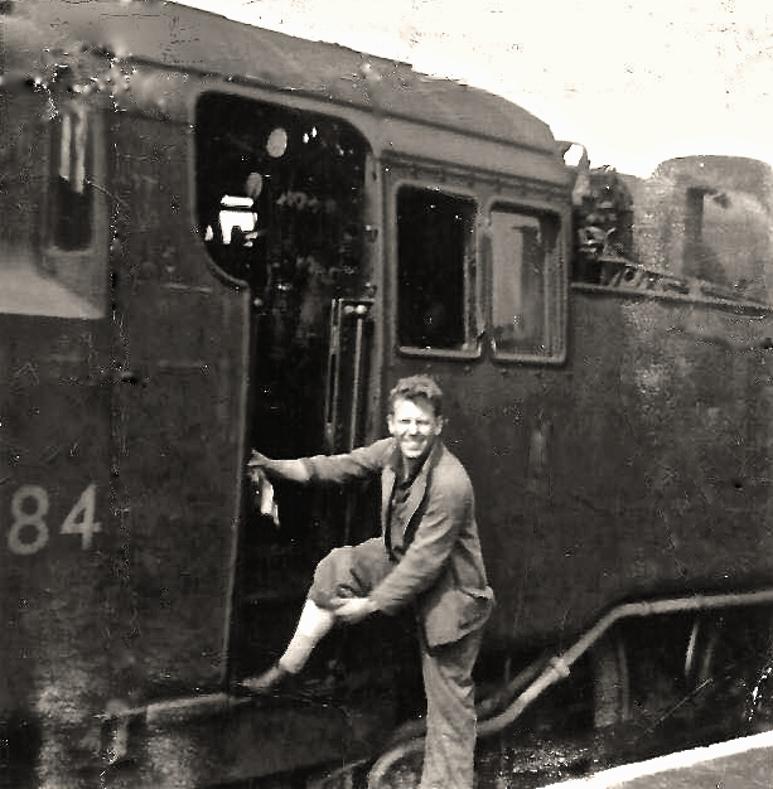
Mike Bean Collection
Tunbridge Wells Driver Alf Cox
LOCOMOTIVE JOURNAL
TUNBRIDGE WELLS
MAY 1960
PAGE 156
It is with the deepest sorrow that we have to report the passing of our later Bro. Cornford, Chairman of this Branch. He was Branch Chairman for 11 years, Chairman of the L.D.C., District Council Delegate, and Borough Councilor 1946 to 1950 and 1953 to 1960. A good councilor and a friend to all in need.
The funeral took place at the Tunbridge Wells Borough Cemetery on Saturday April 2. A service was held at St. Luke’s church, attended by the Mayor and Corporation, and numerous friends and workmates.
Councilor F.G. Robinson, our Secretary, represented the A.S.L.E.&F.
The society has lost a very worthy member.
F.G. Robinson
Branch Secretary
(Our sincerest sympathy is tendered to the bereaved - Editor)
LOCOMOTIVE JOURNAL
LITTLEHAMPTON
MAY 1960
PAGE 191
The quarterly meeting was held March 24 and 27. This branch now holds an evening meeting in addition to normal Sunday meeting each quarter. The success of this venture was apparent in that 80 per cent of available members attend the evening meetings. Good work, chaps! Remember, the life-blood of the Branch officers is the support of the members. No resolution on the Guillebaud Report was made, but its findings were discussed in some detail.
The liveliest discussions came during the submitting of items for the L.D.C. The main cause of complaint was the issue of uniform clothing, which year by year bears no likeness to an organized issue.
Another very sore point under discussion was the lack of messroom facilities at Barnham.
On the question of mesrooms a letter from Brighton L.D.C. was read, which gave rise to some scathing remarks regarding the wooden lean-to shack which passes as a messroom at Brighton. It has since been rumoured, however, that a certain amount of progress is being made in providing more suitable temporary accommodation.
G.J. Knight,
Branch Reporter.
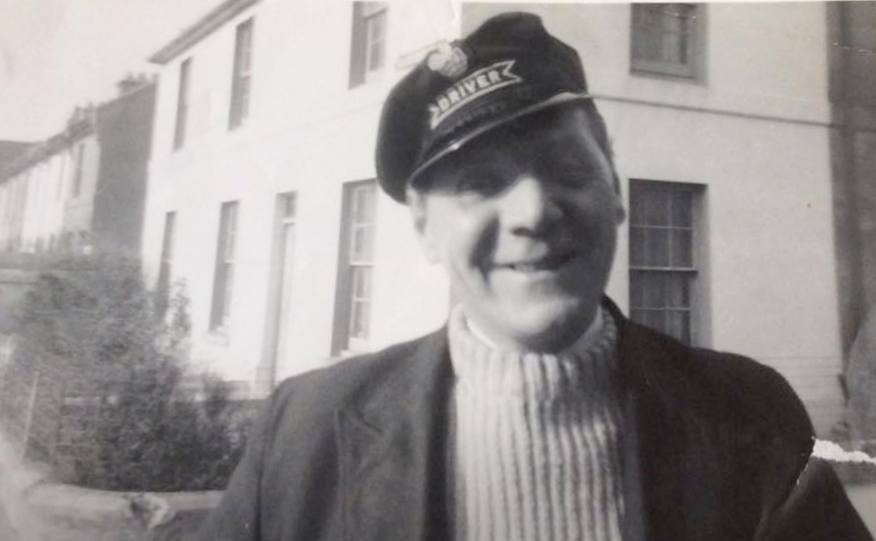
LOCOMOTIVE JOURNAL
AUGUST 1960
LITTLEHAMPTON
PAGE 258
The quarterly meeting of Littlehampton Branch took place on June 30 and July 3. The Chairman extended a welcome on behalf of all, to Bro. R. Tizard, who after two years away from the depot has now passed fit to take up his duties again at this depot. Good luck, Reg, and may you spend many happy years with us in the future.
The report on the wages award was read, and this was received with certain doubts and disappointments.
We at this branch now take pride in having 100 per cent A.S.L.E.&F. membership: the application for membership was received, and accepted, of the one and only “non” at this depot.
G.J. Knight
Branch Reporter.
LOCOMOTIVE JOURNAL
SEPTEMBER 1960
HORSHAM
PAGE 288
Attendance at our recent meetings have been poor considering the messroom moaning.
Your L.D.C. have a lot on their plate these past few months, including such problems as booking of appointed men on loan to other depots, booking of Passed Firemen after performing higher grade work and now it appears we have a new problem; facilities for taking food, for men on train running turns. (Are we like an alarm clock, just wind us up we keep going?) To help your branch officers and L.D.C. solve these problems, and others, attend the branch room and voice your opinion. It’s a lot better done here that in the messroom.
W. Hutchings.
Branch Secretary
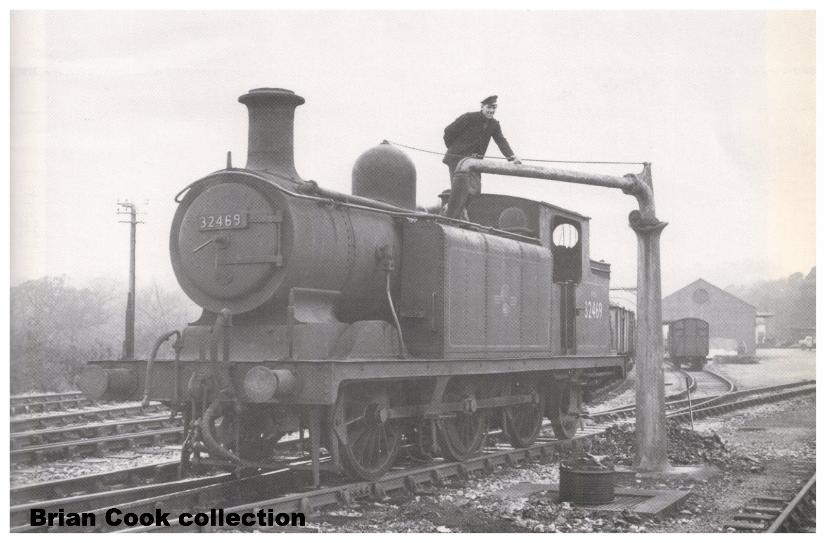
STORIES FROM THE SHOVEL
Memories of the Mid - Sussex line
By Rodney Burstow.
When working up the mid Sussex with a K class Mogul, with 60 wagons on loose coupled, you sure had to know the road them days!!
I once fired to Driver Ted Symons (his used a catch phrase - there and that there) on a "Q", Fratton to Horsham household coal, the shovel never left my hands except to put the injector on until we passed Chichester, couldn't put a lot more on, the bloody tender was empty!! when we run into Horsham Ted said go on boy get yourself a pint, and when we got in the Loco to dispose the engine He told the Foreman to get the P&D to do it.
* E. Symons seniority date 18.03.1918. Ted was a driver at Horsham, and came from the West Country to Horsham, previous depots unknown